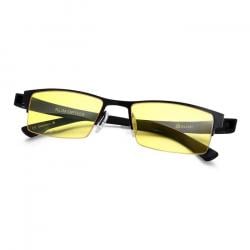 KLIM Optics (Hardware)
KLIM Optics (Hardware)
Official GBAtemp Review
Product Information:
When you use any device with a screen, you’re staring right into the blue light that's constantly being emitted from it. Though many of us spend countless hours staring at our phone or computer screen, it’s not exactly the healthiest thing to do for our eyes. Not only can it cause strain and headaches, but there’s a good amount of studies out there that claim that too much blue light can throw off your circadian rhythm. Software solutions such as f.lux exist, but for those that want to take things one step further, there’s tinted glasses that are built to help minimize eye strain.
As someone who is prone to headaches while spending excessive amounts of time staring at a monitor, yet does not wear any form of eyewear, I was immediately curious about the claims made by KLIM and their Optics line of blue light blocking glasses. These little glasses block up to 86% of blue light, quite a bit more than similar products, including a majority of Gunnar Glasses, the most well-known competitor in this market.
The moment I removed the glasses from their fancy case, and unfolded them to put on, I was a little shocked at how drastic the difference was. I didn't gain magical MLG gaming skills, but I did notice how everything turned a warm yellow tone, far more than I expected. My desktop background, normally a bright blue, suddenly had a different tone, with most blue elements looking as if they'd been straight up removed. Stark white text on black backgrounds or bright white webpages became much easier to handle, especially during the evening, when my surrounding lights were dimmed.
For those that have prescription eyewear, KLIM also offers a clip-on version called the OTG, which attach to the front of any regular pair of glasses in order to provide the same blue light filtering as the Optics. Both of these are quite effective, as I noticed that wearing them during the evening did legitimately help subside the mild headaches I'd been having. They're also comfortable to wear and feel well-made, having a nice matte frame that's light enough to not feel noticeable after hours of use.
At just under $40, these are around the mid-range price tier for blue light filtering glasses. They're not as stylish or flashy as the pricier versions, but they're also much more subtle, meaning you might feel less embarrassed to wear these in front of others. It's also more than likely that buying the cheaper variants won't result in glasses with as strong a lens, or will be ones that won't last long due to cutting corners on build quality. Overall, I'm quite pleased with the KLIM Optics. They're not going to change your life, but for their price, they are a great option if you're someone who spends their day looking at a screen and want to take measures to protect your vision.
Verdict
- Comfortable and lightweight
- Alleviates eyestrain when worn
- Does its job of blocking blue light
- While it cuts down headaches for me, they might not be as effective for others



